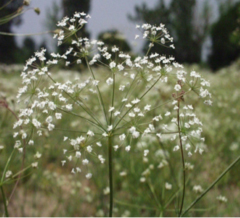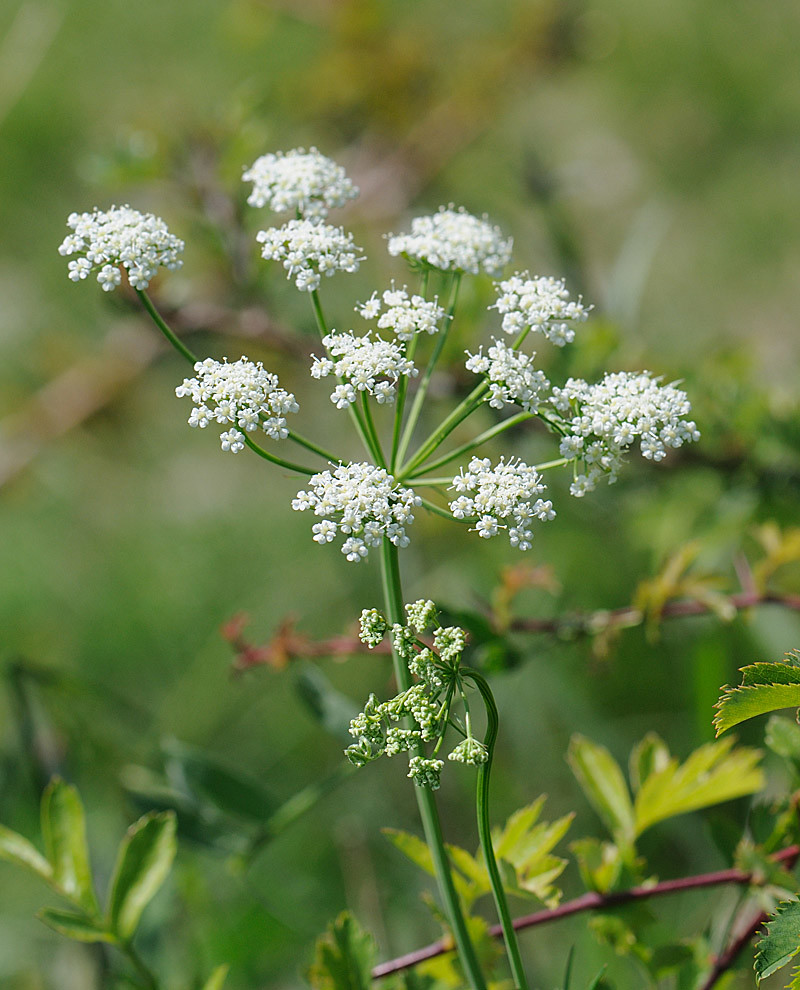Bunium
Usually Knoll cumin ( Bunium bulbocastanum )
Knoll cumin ( Bunium ), like many other plant taxa also called " Erdknolle ", is a genus within the family of Umbelliferae ( Apiaceae ). It occurs naturally only in the Old World. Some types of plant parts are used as a vegetable or spice.
- 5.1 Notes and references
Description
Appearance and leaves
The Knoll cumin species grow as a perennial, herbaceous plants. The roots usually form from spherical tubers. All plant parts are bare.
The leaves are highly divided, two to three times pinnately divided. The leaf segments are filiform to linear.
Inflorescences and flowers
The flowers are in doppeldoldigen inflorescences. In each case, none to three or more bracts and the Hüllchenblätter be present, which are linear to lanceolate.
The relatively inconspicuous, usually hermaphrodite flowers are fünfzählig double perianth. The five calyx teeth are only dimly discernible. The five free petals are pure white to pink or reddish. The nectar- style pads ( stylopodium ) are flattened or conical, narrowing abruptly in the short to long, recurved style. The under constant ovary is bald.
Fruits
The gap fruit, called in this family is Doppelachäne, ovate to oblong or cylindrical, and divided into two partial fruits. The partial fruits are elongated and flattened laterally, similar to the partial fruits of caraway. The raised main ribs are thick. In the little valley there are one to three oil welts. The endosperm is truncated pentagonal and flattened at the joint surface. The fruit holder ( Karpophor ) sometimes shares only up to half.
Dissemination
The Bunium types come from Central Europe via the Mediterranean and the Middle East to Central Asia, Afghanistan and western Pakistan.
System
The genus Bunium was erected in 1753 by the Swedish botanist Carl Linnaeus in Species Plantarum, 1, p 243. Type species is L. Bunium bulbocastanum. Synonyms Bunium L. are Buniella Schischk. , Diaphycarpus Calest. Wallrothia and explosive ..
The genus belongs to the tribe Bunium Pyramidoptereae in the subfamily Apioideae within the Apiaceae family.
There are 30 to 50 Bunium types:
- Bunium afghanicum Beauverd
- Bunium alatum Pimenov & Kljuykov
- Bunium alpinum Waldst. & Kit. ( Syn: .. . Carum alpinum ( Waldst. & Kit) Benth & Hook ex BDJacks. )
- Bunium angrenii Korovin
- Bunium avromanum ( Boiss. & Hausskn. ) Drude
- Bunium badachschanicum camel
- Bunium badghysi ( Korovin ) Korovin
- Bunium bourgaei ( Boiss. ) Freyn & Sint.
- Bunium brachyactis (Post) H.Wolff
- Usually Knoll cumin ( Bunium bulbocastanum L., Syn: Carum bulbocastanum (L.) WDJKoch )
- Bunium capusii ( Franch. ) Korovin
- Bunium caroides ( Boiss. ) Hausskn. ex Bornm.
- Bunium chabertii ( Batt ) Batt.
- Bunium chaerophylloides ( rule & Schmalh. ) Drude
- Bunium cornigerum ( Boiss. & Hausskn. ) Drude
- Bunium cylindricum ( Boiss. & High. ) Drude
- Bunium elegans ( Fenzl ) Freyn ( syn. Carum elegans Fenzl )
- Bunium fedtschenkoanum Korovin ex -camel
- Bunium ferulaceum Sm
- Bunium hissaricum Korovin
- Bunium intermedium Korovin
- Bunium kandaharicum Rech.f.
- Bunium kopetdagense money.
- Bunium korovinii R.Kam. & Money.
- Bunium kuhitangi Nevski
- Bunium lindbergii Rech.f. & Riedl
- Bunium longilobum Klyuikov
- Bunium longipes Freyn
- Bunium luristanicum Rech.f.
- Bunium microcarpum ( Boiss. ) Freyn & Bornm.
- Bunium nilghirense H.Wolff
- Bunium nothum (Clarke) P.K.Mukh.
- Bunium nudum (Post) H.Wolff
- Bunium pachypodum P.W.Ball
- Bunium paucifolium DC.
- Bunium persicum ( Boiss. ) B.Fedtsch. ( Syn: . Carum persicum Boiss, Carum bulbocastanum auct non (L.) WDJKoch. )
- Bunium pestalozzae Boiss.
- Bunium pinnatifolium Kljuykov
- Bunium rectangulum Boiss. & Hausskn.
- Bunium scabrellum Korovin
- Bunium seravschanicum Korovin
- Bunium vaginatum Korovin
- Bunium verruculosum C.C.Towns.
- Bunium wolffii Klyuikov
Use
The tuberous roots of some species are edible and can be eaten raw or cooked as a vegetable. In Bunium bulbocastanum small and difficult to be harvested tubers taste very good after coconut when they are cooked. The Roots of Bunium ferulaceum are very small and have a bitter taste.
The leaves of the ordinary Knoll caraway be raw or cooked similarly used as a culinary herb such as parsley. The flowers of Bunium bulbocastanum be used fresh to flavor and decoration.
The partial fruits of Bunium persicum and Bunium bulbocastanum be called Black cumin and used as a spice; they are a cumin substitute.
The medical effects of Bunium bulbocastanum were examined; it acts as an astringent.
Swell
- Eugene Nasir: Umbelliferae: Bunium text Registered as printed work, In: . Flora of West Pakistan, Volume 20, Stewart Herbarium Gordon College, among other things, Rawalpindi 1972 (Sections Description and systematics)






.jpg)
.jpg)


.jpg)